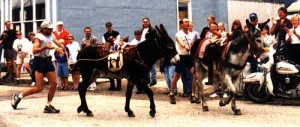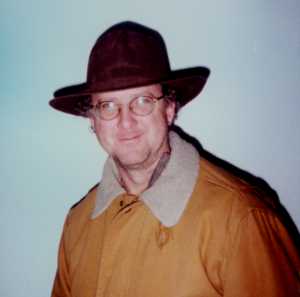Review by Ed Quillen
Law Enforcement – March 2004 – Colorado Central Magazine
In the Name of the People – The True Courtroom Drama of the People of Colorado versus John Gates
by Peter John Stone
Published in 2004 by Open Range Media
ISBN 0-7795-0050-4
THE BASIC FACTS were pretty simple. On the night of June 8, 2001, John Gates, 19, and his passenger friend, 21-year-old Jamie Schaffer, were parked in front of some stores along U.S. Highway 285 in the Bailey area. Deputy Sheriff Carl Sharp, who was patrolling the area in a marked car, thought it looked suspicious, as though the two young men planned to rob one of the stores.
He pulled up, questioned the young men, and soon arrested Gates on a variety of charges. When Gates arrived at the Park County Jail, more than 40 miles away near Fairplay, he had a big cut on his head and blood all over his face.
Gates was charged with driving under the influence, obstructing a peace officer, resisting arrest, and criminal mischief. The trial, which began on March 4, 2002, lasted four days. It took a Fairplay jury about 45 minutes to acquit Gates of all charges.
That’s the condensed version of the story, which got little local coverage at the time. Peter John Stone, a former reporter for the Fairplay Flume, attended the trial and built this book from the courtroom presentations.
Although more than a dozen witnesses testified, there were at heart only two versions of that night’s events: the deputy’s and the defendant’s. And the defendant said his version was clouded by a concussion from a blow to the head that night, so his testimony wouldn’t agree with other testimony, even testimony from defense witnesses.
Under those circumstances, it’s astonishing — at first anyway — that the jury chose to believe the defendant and acquit, rather than concur with Deputy Sharp and convict Gates.
But in essence, it was Sharp, or at least his credibility, that was on trial. That’s not how criminal trials usually work, but the inconsistencies in Sharp’s testimony left the jury little choice. They had to believe Sharp to convict Gates, and his account wasn’t credible.
Gates and Schaffer said they had pulled up to patronize a liquor store (Gates wanted a pack of cigarettes), which sat next to a feed store and a gun store (which Sharp was a part-owner of). Gates told Schaffer to stay in the car, but he didn’t — he followed Gates into the liquor store. Meanwhile, Gates’s dog Shamus, a big German shepherd, got loose. So after they left the liquor store, they were looking for the dog. Gates had decided to just sit in the car and wait for Shamus to return when Sharp drove up.
Sharp said the dog was in the car then. But witnesses at a restaurant across the road saw the dog loose at about that time.
That’s a minor inconsistency, but one that would have bothered me if I’d been on the jury.
Then there was Gates’s head injury. Its shape matched the end of the magazine of the pistol that Sharp was carrying, as though Gates had been pistol-whipped. Sharp said Gates had acquired the injury by banging his head against a window, but there was nothing in the car that would have produced Gates’s wound.
Further, Sharp’s explanation of where and when things happened as he attempted to transport Gates to the Fairplay jail did not fit the circumstances. Sharp’s driving speed would have had to exceed 120 m.p.h. to make his scenario fit, and those of us familiar with twisting 285 in the Bailey area know that’s impossible.
Reading this book is kind of like sitting on a jury, because Peter John Stone presents the story in just the way it was presented in the courtroom, in the same order, with the text pretty much confined to the testimony.
That method does involve the reader — you keep wondering who’s going to testify next and answer the questions you have — but in some ways you wish the author had gone outside the court case to get more information to fill out the story.
One thing that impressed me, though, was what lay behind the book — our trial system. People complain about it all the time, and I’ve witnessed courtroom maneuvers that seemed highly dubious, but it struck me that this trial seemed to represent an honest effort to determine what really happened. We have an adversarial system, so there were two sides with two different accounts, but I got the feeling that justice was served.
Served up to a point, anyway. Gates’s acquittal meant that Sharp was guilty of some unprofessional conduct at the least: mistreating a prisoner and then lying about it. Yet Park County Sheriff Fred Wegener took no action against him.
–Ed Quillen



